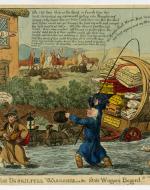Created by Laci Dezern on Wed, 10/02/2024 - 22:59
Description:
Jane Austen spent most of her life during wartime, being born a bit after the start of the American Revolutionary war and dying about two years after the end of the Napoleonic wars. With England in war for over forty years means the need for war funds was always a priority. This money usually came from the citizens of the country through raised takes. The print depicted was drawn by Charles Williams in retaliation to the British government heavily taxing the people to pay off the government’s debts. In the satirical piece, the common man—John Bull— is giving resisting in Prime Minister Henry Addington tax money. An overloaded cart and horses representing other government officials can be seen around the main characters and in the background.
Generally, there were varying viewpoints of the military depending on the person and their rank, class, and standing. Jane Austen’s society always accepted “soldiers and sailors…in society” (Byrne 123). She herself had a brother—Henry Austen—who was in the Navy and Jane Austen based much of her experiences with the militia from her brother’s letters and visits. While she was “proud of her brother’s achievements,” Austen still “reduced the importance of national events by presenting them from the point of view of a private person (Deforest). This may be because of the general want to present a perfect reality in fiction novels. The military are supposed to be heroes, and not all of them are exactly like the stereotype portrayed.
There are people in society that do not care for the military, especially in public while in their uniforms. These particular men in the streets of England “saw less action than revelry,” and the militia officers “are poor officers,…are morally insensitive,…and…may exploit impressionable young women” (Amoruso). Military men, according to Austen’s Pride and Prejudice storyline, are younger sons that have less opportunities to marry where they would like. These men such as George Wickham are not eldest sons and cannot inherit his fathers’ estate and therefore does not have a solid monetary value or stable social status. Wickam is a villain in the sense that he steals a naïve Kitty from her family before she had fully matured, and in return was forced to ask and beg for money the rest of her life.
Works cited
Amoruso, Malika. “‘Not Every Single Man Is Looking for a Wife’: Austen, Fordyce, and Fire Island.” Jane Austen Society of North America, jasna.org/publications-2/persuasions-online/volume-44-no-1/amoruso/. Accessed 7 Oct. 2024.
Byrne, Paula. The Real Jane Austen: A Life in Small Things. HarperPerennial, 2014.
https://artcollection.dcms.gov.uk/artwork/15725/
Boone, Joseph Allen. “Tradition Counter Tradition: Love and the Form of Fiction.” Google Books, University of Chicago Press, books.google.com/books/about/Tradition_Counter_Tradition.html?id=3i9sQgAACAAJ. Accessed 8 Oct. 2024.
Williams, Charles, and S. W. Fores. The unskilfull waggoner or the state waggon bogged!!! 1804.
Copyright:
Associated Place(s)
Part of Group:
Featured in Exhibit:
Artist:
- Charles Williams


